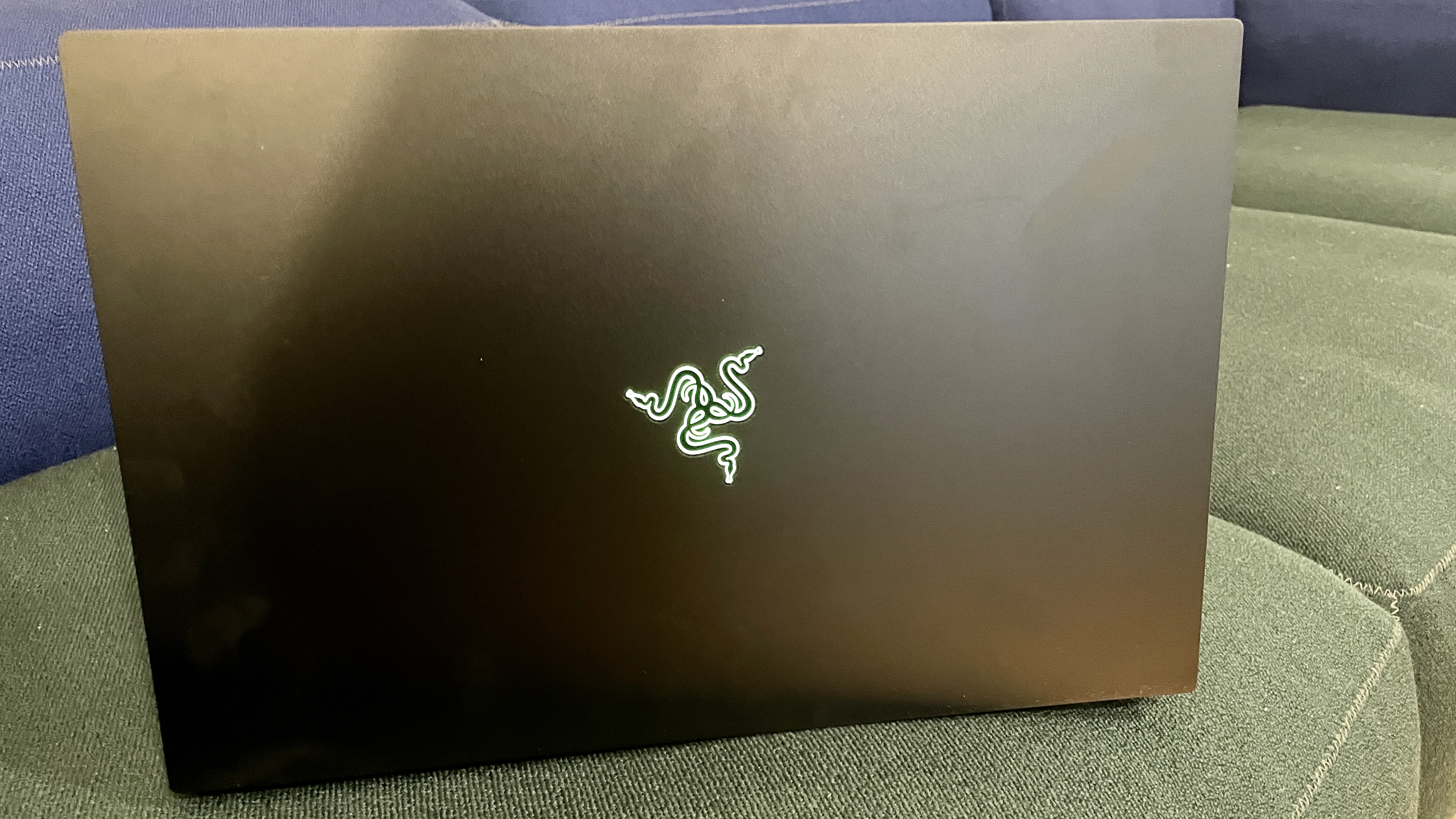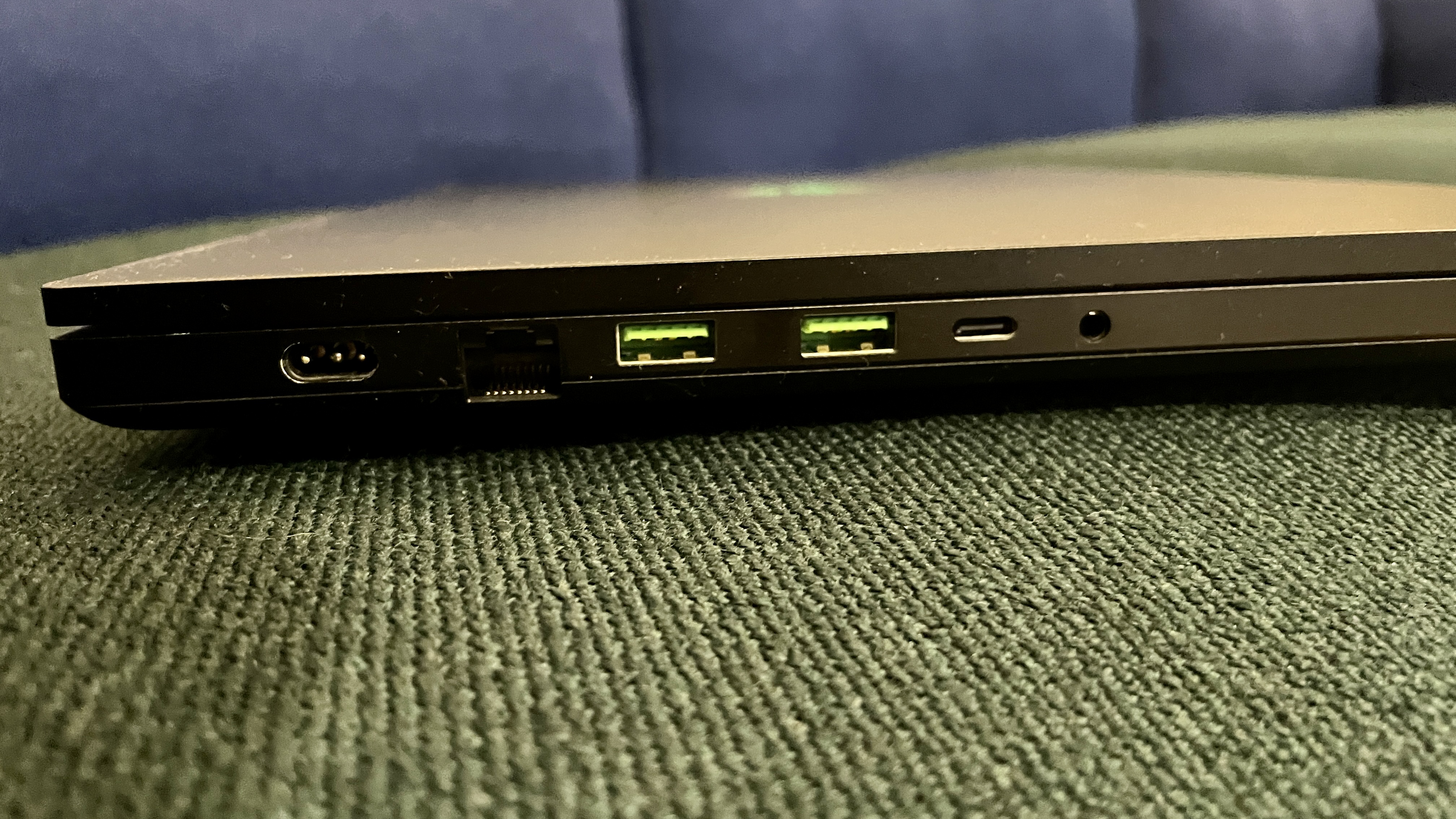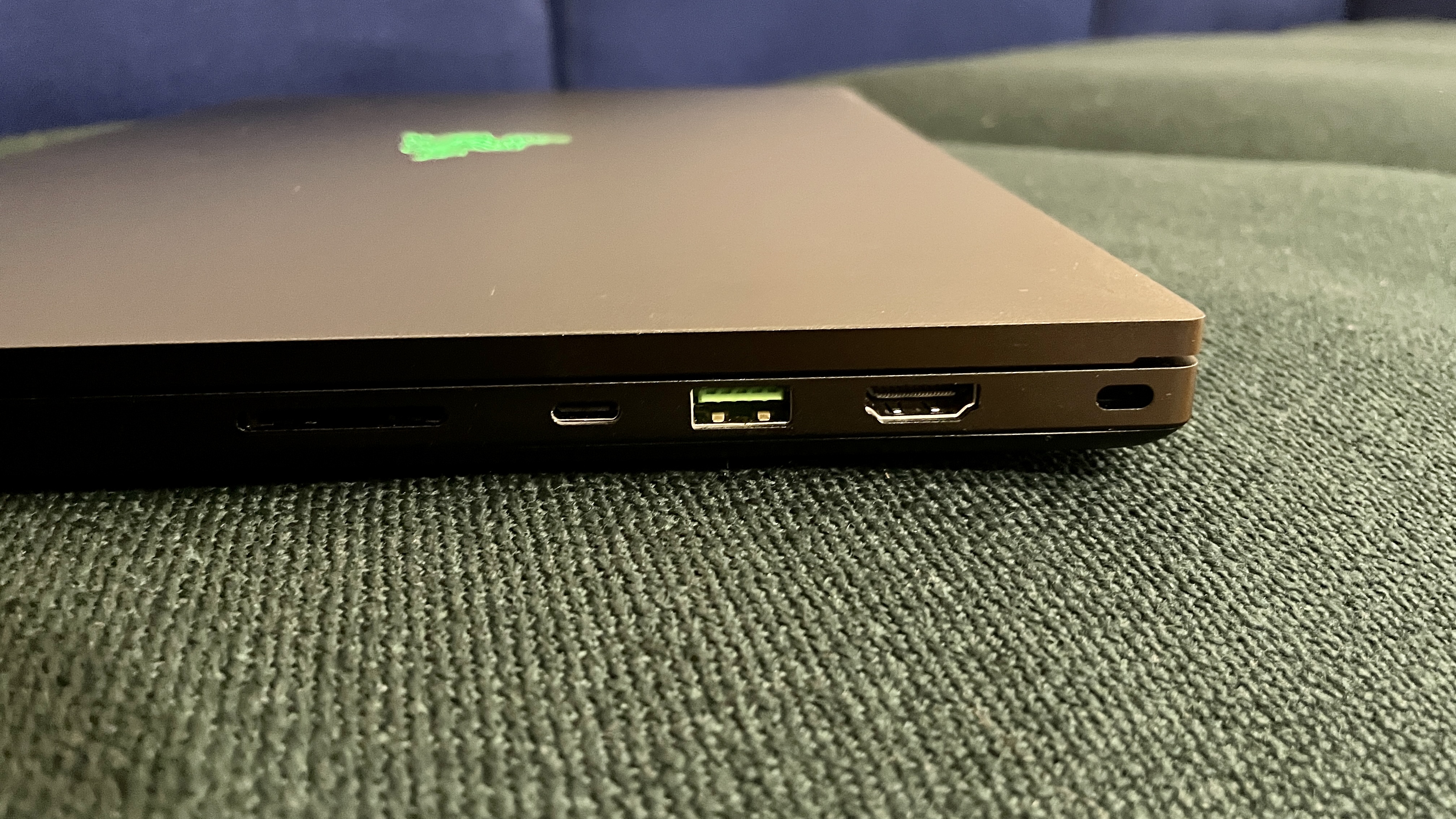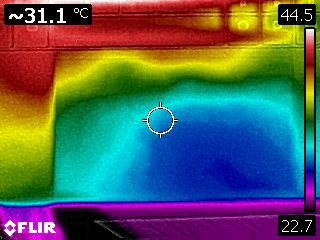Tom's Hardware Verdict
Despite the Razer Blade’s bevy of ports, 1080p webcam, and powerful GPU, there are other 17-inch gaming notebooks that offer stronger CPUs at a lower price than this configuration.
Pros
- +
+ Lots of ports
- +
+ 1080p webcam
- +
+ Extra M.2 slot
Cons
- -
Lower productivity performance than competitors
- -
Pricey
- -
Hollow speakers
Why you can trust Tom's Hardware
Not all 17-inch gaming laptops are bulky. Razer's overall aesthetic is thin, even with its largest gaming notebook, the Blade 17 ($2,699 to start, $3,999 as tested).
What’s more, all the configurations for the Razer Blade 17 pack the latest processors from Intel and Nvidia’s new RTX 30-series graphics cards into a sleek, thin profile. This version also comes with per-key backlights, DDR5 RAM, and a new anti-fingerprint coating. The manufacturer has even taken the power button out of its speaker and made it a key on the keyboard while also dropping the “Pro” from its naming scheme.
The Razer hosts several ports, a nifty 1080p webcam, and a QHD 17.3-inch display. These specs make the Blade an easy contender for our best gaming laptops page on paper. But you have to be willing to pay Razer's premium price tag, even when some similarly specced laptops offer just as much, if not more power.
Design of the Razer Blade 17
This iteration of the Razer Blade 17 doesn’t stray too far from previous models. The black aluminum chassis looks sleek and professional. Unfortunately, its anodized matte finish attracts a lot of streaks, specs, and fingerprints, despite its anti-fingerprint coating. The Razer snake logo is front and center on the chassis, and it glows a green hue. I wish the logo’s RGB could be customized in Synapse or turned off entirely, as a green snake isn't appropriate in every setting.



This 17.3-incher is a leviathan in terms of size, but it doesn't use all of the real estate. I noticed just how bare and minimalist the design was when I first opened the lid. The bezels surrounding the 16:9 aspect ratio display are thin around the sides and top, but the 6 mm bezel on the bottom is rather large. However, given the size of its display, the Razer Blade 17 sports an impressively thin profile, one of the most slender offerings in the market.
The keyboard is very compact, mostly to fit its twin speakers on either side. There are about two inches between the keyboard and the ventilation gap underneath the display that’s just empty. Some gaming laptops put the power button and dedicated volume keys above the keyboard, but on the Razer it's just bare aluminum, with the power button on the keyboard. Each key has individual backlighting powered by Razer's Chroma lighting that can be customized to use an assortment of colors or effects. Below the keyboard, the Blade also houses a sizable 5.1 x 3.1-inch trackpad.
There are an extensive number of ports on the Razer Blade 17. On the left side, there’s a power jack, an Ethernet port, one USB Type-A port, one Thunderbolt 4 USB-C port and a 3.5mm headphone jack. On the right side, there’s a UHS SD card reader, another Thunderbolt 4 USB-C port, two USB Type-A ports and an HDMI 2.1 output next to a Kensington security lock. One of the USB-C ports also supports power delivery, which you could use for trickle charging.
Get Tom's Hardware's best news and in-depth reviews, straight to your inbox.
The Razer Blade 17 measures 15.55 x 10.24 x 0.78 inches (395 x 260 x 19.9 mm), which is about the same width and height as the Alienware x17 R2 is 15.72 x 11.79 x 0.84 inches. Meanwhile, the MSI GE76 Raider and Gigabyte Aorus 17 XE4 are 15.63 x 11.18 x 1.01 inches and 15.7 x 10 x 1.10 inches, respectively. Both are slightly thicker than the Razer Blade 17 but ride close to its depth. The Aorus takes the crown for the lightest at 5.95 pounds, with the Razer Blade 17 right behind it at 6.06 pounds. Next is the GE76 Raider at 6.39 pounds, and lastly, the Alienware x17 R2 is the heaviest at 6.82 pounds.




Razer Blade 17 Specifications
| CPU | Intel Core i7-12800H |
| Graphics | Nvidia GeForce RTX 3080 Ti |
| Memory | 32GB DDR5-4800 |
| Storage | 1TB PCIe Gen4 NVMe SSD |
| Display | 17.3-inch QHD (2560 x 1600) IPS 16:9, 240 Hz |
| Networking | Killer Wi-Fi AX1650 2x2, 2x2 WiFi 802.11ax, Bluetooth 5.1 |
| Ports | 3x USB 3.2 Gen 2 Type-A, 2x Thunderbolt 4 over USB Type-C, HDMI 2.1, UHS-II SD card reader, 3.5 mm headphone jack, 2.5Gbps Ethernet port, Kensington lock slot |
| Camera | 1080p webcam |
| Battery | Killer Wi-Fi AX1650 2x2, 2x2 WiFi 802.11ax, Bluetooth 5.182 Whr |
| Power Adapter | 280W |
| Operating System | Windows 11 Home |
| Dimensions(WxDxH) | 15.55 x 10.24 x 0.78 inches (395 x 260 x 19.9 mm) |
| Weight | 6.06 pounds (2.75 kg) |
| Price (as configured) | $3,999 |
Gaming and Graphics on the Razer Blade 17
Our configuration unit of the Razer Blade 17 came with an Nvidia GeForce RTX 3080 Ti GPU with 16GB of VRAM and an Intel Core i7-12800H CPU.
In my personal playthrough of Shadow of the Tomb Raider, I played the game at 1440p at the highest setting, with RTX DLSS set to Quality. The title fluctuated between 84 and 109 frames with a 99 percentile that fluctuated between 65 and 75 frames. However, I ran into a graphics issue that caused in-game flickering during the opening Day of the Dead sequence. Nonetheless, the gameplay remained smooth as I climbed out of a collapsing tomb and inconspicuously eavesdropped my way through the Mexican celebration with Lara.





On the Shadow of the Tomb Raider benchmark (highest settings), the Blade 17 churned out 116 fps at 1080p. The Blade topped the GE76 Raider’s 112 fps, the Alienware x17 R2’s 107 fps, and the Aorus 17’s 89 fps.
During the Far Cry New Dawn (ultra settings) benchmark, the Blade lost the lead, running the game at 96 fps at 1080p. The Aorus 17 followed up at 105 fps and behind that is the GE76 Raider. The Alienware x17 R2 took the crown, coming in at 117 fps. When we ran the benchmark in 1440p, the Blade 17 dropped to 91 fps.
On the benchmark for Grand Theft Auto V (very high settings), the Blade’s average frame rate of 132 fps was again by the GE76 Raider’s 139 fps. Alienware x17 R2, at 129 fps, was ten frames behind the Raider and the Aorus 17 reached 105 fps. When we ran GTA V in 1440p on very high settings, the Blade 17 hit 89 fps.
During the Borderlands 3 (FHD) benchmark at 1080p, the Blade reached 99 fps, just two frames ahead of the Alienware x17 R2’s 97 fps. The Aorus got the lowest number with 81 fps, while the Raider hit the highest at 106fps.
On the Red Dead Redemption 2 benchmark (medium settings), the Blade 17 reached 84 fps, the most frames at 1080p compared to its rivals. The Alienware x17 R2 hit 78 fps, and the Aorus 17 was only two frames behind at 76 fps. The GE76 Raider came the closest to the Blade with 82 fps. When the game was benchmarked at 1440p, the Blade achieved an average of 62 fps.
On gaming laptops, we test the system by running the Metro Exodus benchmark on RTX settings 15 times, simulating about half an hour of gameplay. The game ran at an average of 58.3 frames per second.
During the stress test, CPU speeds came in at an average of 2.9 GHz on the performance cores and 2.29 GHz on the efficiency cores. The temperature of the chip averaged 44.5 degrees Celsius. The GPU ran at an average of 210 MHz and a temperature of 55.7 degrees Celsius (132.3 degrees Fahrenheit).
Productivity Performance on the Razer Blade 17
We tested the Razer Blade 17 with an Intel Core i7-12800H with 32GB of DDR5 4800MHz RAM and 1TB of PCIe Gen4 NVMe storage. Those are strong specs, but some other laptops outperformed it on our productivity tests.



During our Geekbench 5.4 testing, we found the Razer Blade 17 to be the weakest performer in both single and multi-core operations when compared to similarly specced laptops. The Razer Blade 17’s single-core score was 1,741 with a multi-core score of 9,875, the lowest of the bunch. Meanwhile, the Alienware x17 R2 (Core i9-12900HK) held the crown in both single and multi-core scores of 1,824 and 13,710, respectively. The MSI GE76 Raider 12UHS (Core i9-12900HK), with a single-core score of 1,833 and a multi-core score of 13,456, was right on its tail. Last in the pack was the Gigabyte Aorus 17 XE4 (i7-12700H), which was not too far behind the Raider and Alienware with a 1,781 single-core score and an 11,979 multi-core score.
During our Handbrake test, the Razer Blade 17 took the longest of the group to transcode a 4K video to 1080p at 7 minutes and 19 seconds. A couple of seconds ahead is the Gigabyte Aorus 17 at 5:36. Meanwhile, the Alienware x17 R2 and MSI GE76 Raider were neck and neck for the fastest at 4:45 and 4:44, respectively.
The Razer Blade 17 also copied 25GB of test files at an average of 1,239.88 MBps, the slowest out of the bunch. In third and second place are the Aorus 17 XE4 and the GE76 Raider at 1,475.15 and 1,774.47 MBps, respectively. The Alienware x17 R2 and its 2,268.18 MBps was the fastest.
Display on the Razer Blade 17
The Razer Blade 17 sports a 17.2-inch QHD (2560 x 1600) IPS display with a 16:9 aspect ratio and refresh rate of 240 Hz. In my everyday use, the display produced vibrant pictures when watching the trailer for Jurassic World Dominion.
I noticed how crisp everything was in the snowy opening setting, including the frost-tipped mountains in the background. When we got a close shot of our protagonist, I noticed signs of aging in Chris Pratt’s face for the first time. All the establishing shots in the trailer looked cinematic in 4K.
When I played Grand Theft Auto V and Shadow of the Tomb Raider, the display delivered cinematic quality. Although I’ve played this installment of Grand Theft Auto multiple times across several different console generations, the 17-inch, QHD screen immersed me in the title again. It was almost time for me to leave the office for the day, and it took an effort to pull myself away from the Blade.
The screen goes up to 240 Hz, but you’ll have to play some older titles or games under lower settings to truly utilize that refresh rate.
The Blade 17's panel covered 117.6% of the DCI-P3 color gamut and 166% of the sRGB gamut. In comparison, no other laptop in the testing pool went above 100%, with the Alienware x17 R2 having the second-highest DCI-P3 color gamut at 76%. The x17 and Aorus showed off the same 107% sRGB color gamut, with the GE76 Raider being the lowest at 105%.
However, our test laptop only hit an average brightness of 294.4, the second brightest compared to the x17’s 325 nits. Behind the x17 is the Aorus 17 with 275 and the Raider with 259 nits.
Keyboard and Touchpad on the Razer Blade 17
The keyboard for the Razer Blade 17 and I have a love/hate relationship. I love how it feels when I type. There are tactile clicks and RGB lighting on the keycaps that can be customized with the Synapse software. I could feel the input of every keystroke to my satisfaction. However, I did find the keyboard itself to be a bit too compact at times, especially since the power button is now on the keyboard, rather than near the right speakers
I hit the power button more than once during my time with the laptop while trying to hit delete or the backspace button. The previous Razer Blade model had the power button indented inside the right speaker, and I suppose this is an improvement over that. To be fair, many laptop manufacturers put the power button in this location, but I'm just not a fan of it. I wish Razer would have used some of the space above the keyboard as its new location.
The touchpad is a sizable 5.1 x 3.1 inches and is made of glass, which felt nice throughout my experience using Windows.
Audio on the Razer Blade 17
Like previous Razer Blade models, the 17 utilizes THX Spatial Audio, which is a type of 7.1 surround sound created by THX (which Razer owns). There’s a standalone app for it that has an equalizer and presets for music, gaming, voice, and movies.
When I initially saw the dual speaker design, I thought I’d be in for an audio treat the likes I’ve seen with the Lenovo IdeaPad Slim 7 Carbon or the 16-inch MacBook Pros. But alas, I was disappointed with its sound quality.
When I used Spotify to listen to music, I started out listening to “I Would Die 4 U” by Prince, and none of the excitement from that track carried over during playback. Everything was flat and hollow. Prince would be outraged if he ever heard such a bombastic song sound so lifeless. I could listen to the synths, vocals, and guitars well enough, but there was little to no bass and a lack of punch to the kicks.
When I opened the THX app, I realized I was already using the music preset, which diminished any hope I had of improving the audio. I also found THX was baked into the default RealTek audio and that I had no option just to use stereo. Although the spatial audio felt very immersive when I used my gaming headset to play Shadow of the Tomb Raider, the experience didn’t translate when using the default Blade speakers, especially when listening to music.
Upgradeability on the Razer Blade 17
The Blade 17's bottom cover is held by 10 Torx screws (I used a T5 head). Most of the screws came off well enough, except one that became stripped inside the laptop. I wondered if any other users had the same issue specifically and I found several threads on Reddit from folks going through the same thing with their various Razer Blade models.
If you do get it open, you'll see Razer's vapor cooling chamber which takes up a lot of space up top. There’s also a second, open M.2 Slot that supports 2-sided NVMe Drives that’s also upgradeable to 4TB. Both sticks of RAM are slotted, rather than soldered, into the motherboard.
Battery Life on the Razer Blade 17
If you plan on lugging this hulking 17-inch Razer Blade around everywhere, you’re going to have to bring its 280W power adapter, which is also big and bulky.
he Razer Blade 17 lasted for 4 hours and 33 minutes on our battery test , which continuously browses the web, streams video, and runs OpenGL tests while connected to Wi-Fi with the screen at 150 nits of brightness. Meanwhile, the Aorus 17 XE4 and GE76 Raider lasted 4:06 and 4:05, respectively. The shortest battery life was on the Alienware x17 R2 clocking in at 2:58.
Heat on the Razer Blade 17



I tested the Razer Blade 17 to see how hot to the touch it gets while running the Metro Exodus benchmark 15 times in a row. At the center of the keyboard, the laptop reached 42.7 Celsius (108.6 Fahrenheit). I’ve tested much hotter laptops during these benchmarks, and although 108 degrees is hot, it’s not too bad for a gaming laptop. We did notice that the fans spin like a jet engine, but that’s somewhat normal. As usual, the hottest spot was on the bottom, which reached temperatures of 43.9 Celsius (111.02 Fahrenheit).
Webcam on the Razer Blade 17
Like previous iterations of the Razer Blade, the Razer Blade 17 houses a 1080p webcam. It is always welcoming to see a bump up from standard 720p webcams we usually see on ultrabooks and gaming laptops alike. Although the quality isn’t perfect, I appreciate being in HD during meetings.
During my time in my well-lit office, the webcam was able to catch details from my finger tattoos, and at first glance, I couldn’t see any pixelation. As I drew my face closer to the webcam, I saw pixelation around my skin and clothing.
The webcam can be oversensitive to light, as it could not capture anything from our windows besides the beaming sun. The light from inside the office also reflected off the puff embroidery across the arm of my hoodie. It made it difficult to read clearly and made its red color lighter than it looks in real life.
But all in all, we were delighted with the quality a webcam of this magnitude could produce. Naturally, there are better camera options in our best webcams list.
Software and Warranty on the Razer Blade 17
The Razer Blade 17 is thankfully light on preinstalled software. Only Razer Synapse and THX Spatial Audio are onboard. Razer Synapse allows folks to customize Razer Chroma lighting, change between performance and GPU modes and create macros.THX Spatial Audio is an app with an equalizer and presets for music, gaming, voice, and movies.
On the Windows 11 side, there are a few of the usual bloatware suspects, such as Spotify, TikTok and Disney Plus, and the like.
Razer sells the Blade 17 with a 1-year limited warranty and a 2-year limited battery warranty.
Configurations of Razer Blade 17
We tested a $3,999.99 Razer Blade 17 configured with an Intel Core i7-12800H, an Nvidia GeForce RTX 3080 Ti, 32GB of RAM, a 1TB SSD, and a QHD (2560 x 1440) display with a 240 Hz refresh rate.
The base model of the Blade 17 features the same CPU but with a GeForce RTX 3060. 16GB of RAM, 1TB SSD, and a QHD (2560 x 1440) display with a 165 Hz refresh rate at $2,699.99. There’s a $3,199.99 version that ups the GPU to an RTX 3070 and uses the same 240 Hz display on our review model.
There’s also a version similar to our test model that costs the same $3,999.99 with the exact specs except for a 1920 x 1080, 360 Hz refresh rate display. Lastly, there’s a Razer Blade 17 with an Intel Core i9-12900H, GeForce RTX 3080 Ti, 32GB of RAM, 1TB SSD, and a new 4K 144 Hz display for $4,299.99.
Each Razer Blade 17 ships with Windows 11 Home.
Bottom Line
The Razer Blade 17 is a fine machine built with powerful components and a large display stuffed into a very slim profile. For some, the Blade’s performance doesn’t match its extreme price tag. Compared to other 17-inch and similarly specced laptops, the Razer Blade falls short in our productivity benchmarks. The Blade took the longest to transcode 4K video and to transfer data files. It was largely fine in gaming, however, especially at 1080p.
A similarly-specced Alienware x17 R2 costs $3,674.99, but is a bit heavier than the Razer Blade 17. That’s a few hundred dollars short of the Blade’s $4,000 price tag, but with a superior Core i9-12900HK CPU and the same DDR5 RAM that’s jacking up the cost of these laptops in the first place.
Other laptops, such as the MSI Raider GE76, exceed the Razer Blade’s hefty price tag but include an improved 4K display and a more powerful CPU. But the tradeoff is the Raider is super thick in comparison to the Blade. For those who want their 17-inch laptop to be as sleek and thin as possible, the Blade 17 is still one of the best choices from an aesthetic standpoint. For those who like to upgrade, there's a free M.2 slot for more storage and plenty of ports for peripherals.
But, at this price range, there are laptops that offer similar, if not more powerful configuration options, sometimes for a few bucks less to boot. But if you need a powerful, yet portable laptop with 17-inches worth of screen, you should consider the Razer Blade 17.

Isaac Rouse is a staff writer at Tom's Hardware. He reviews laptops and various gaming peripherals.

